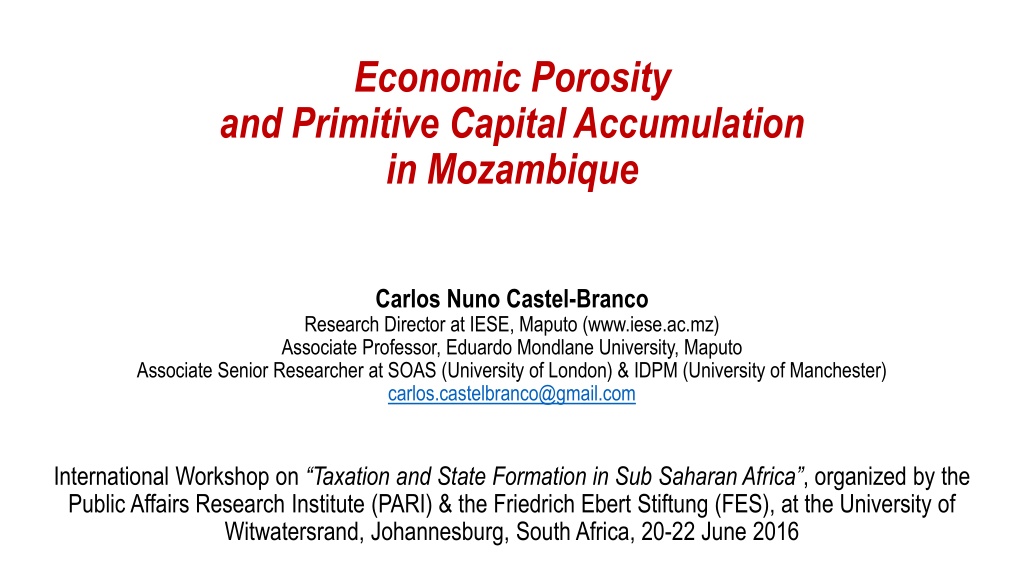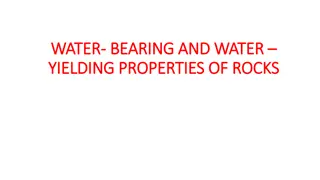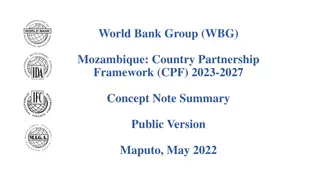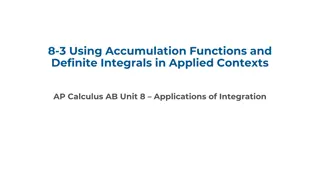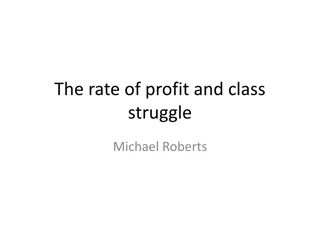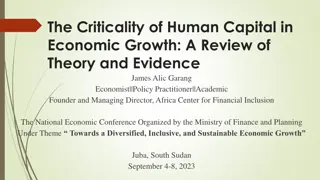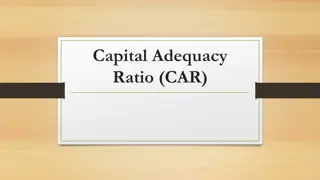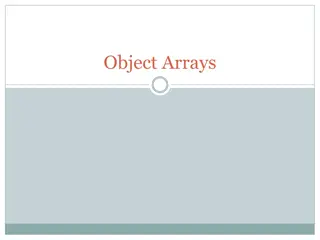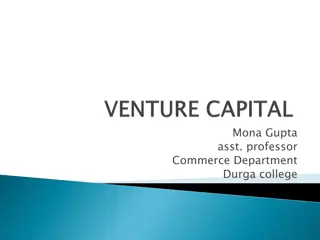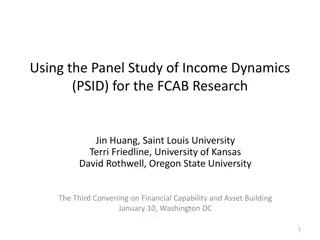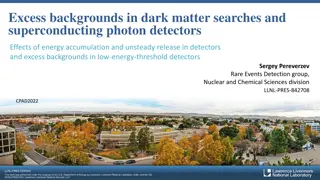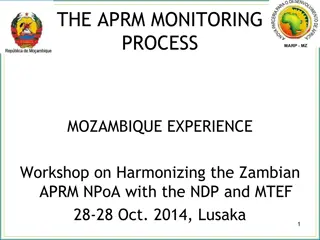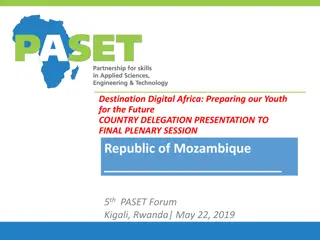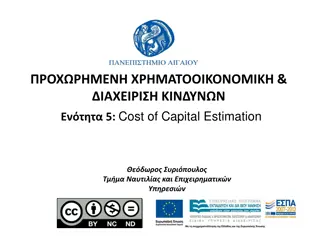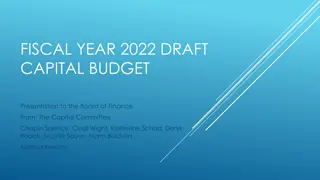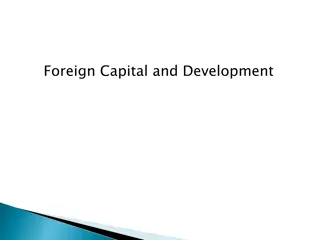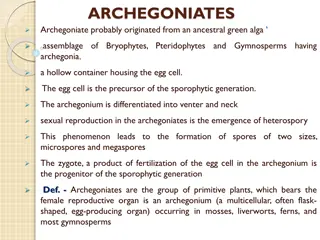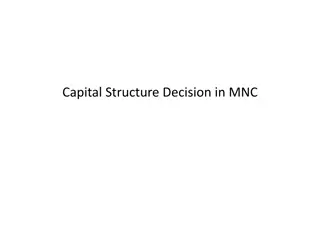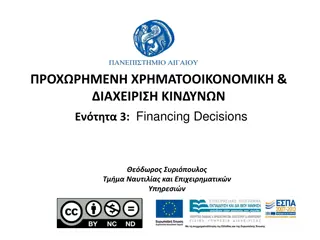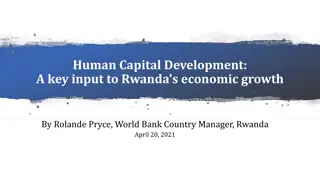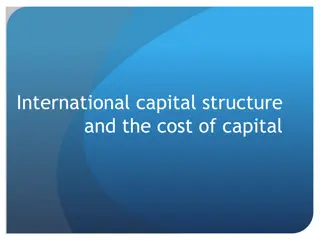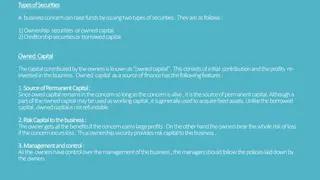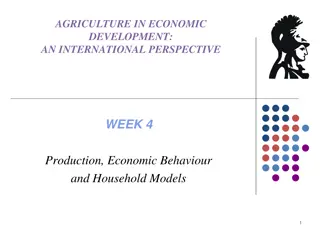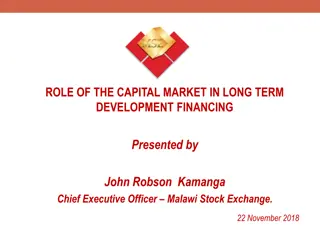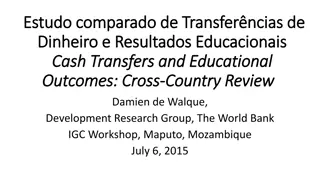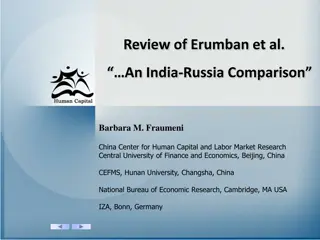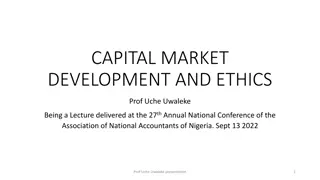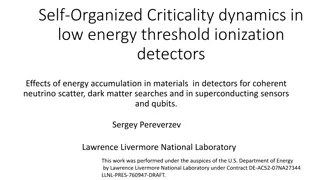Understanding Economic Porosity and Primitive Capital Accumulation in Mozambique
In this presentation by Carlos Nuno Castel-Branco, the concept of economic porosity and its consequences in Mozambique are examined. The discussion includes the historical rationale for economic porosity, magnitude of economic dynamics, taxation issues, investment patterns, capital flight, and public debt challenges. The broader perspective of taxation and state formation within the political economy context is explored, looking at social priorities, alternatives to taxation, and the relationship between state, capital, and labor.
Download Presentation

Please find below an Image/Link to download the presentation.
The content on the website is provided AS IS for your information and personal use only. It may not be sold, licensed, or shared on other websites without obtaining consent from the author. Download presentation by click this link. If you encounter any issues during the download, it is possible that the publisher has removed the file from their server.
E N D
Presentation Transcript
Economic Porosity and Primitive Capital Accumulation in Mozambique Carlos Nuno Castel-Branco Research Director at IESE, Maputo (www.iese.ac.mz) Associate Professor, Eduardo Mondlane University, Maputo Associate Senior Researcher at SOAS (University of London) & IDPM (University of Manchester) carlos.castelbranco@gmail.com International Workshop on Taxation and State Formation in Sub Saharan Africa , organized by the Public Affairs Research Institute (PARI) & the Friedrich Ebert Stiftung (FES), at the University of Witwatersrand, Johannesburg, South Africa, 20-22 June 2016
Struture of the presentation Taxation and State formation within a broader, political economy perspective to understand problems and challenges, to understand and define direction of change Economic porosity: definitions and consequences The argument: historical rationale for economic porosity Magnitude of economic porosity: Structure of economic dynamics, Taxes on mega projects, Investment and reinvestment, Capital flight, Public debt Questions/challenges for taxation and State building 2
Taxation and State Formation within a broader, political economy perspective 3
Taxation and State formation within a broader, political economy perspective What do we want to do/achieve? Social priorities Are there Alternatives to Taxation? Tax Whom or What? Answers to those questions depend on Economic structures, history and dynamics System of accumulation of private capital Relationship between the State, Capital and Labour Can the State Tax? How Much? 4
Defining Economic Porosity Inability, deliberate or nor, to retain, socially, uncommitted surplus that could be utilised for the reproduction of the economy as a whole Three types of economic porosity Type I: outflows of surplus from the domestic to the world economy, that would favour foreign capital. Most of type I porosity may be captured, ceteris paribus, by the difference between GDP and GNP (if GDP > GNP, economic porosity > 0) Type II: transfers of surplus and income from public to private (domestic and foreign) capital, particularly frequent and intense in times of crisis and initial (primitive) stages of capital accumulation (reigniting or igniting processes of private capital accumulation). We can, also, describe this process as one of expropriation of the state for private gain. Type II porosity may not be fully captured by GDP > GNP, as part of the social loss through porosity becomes a private gain in profits, interest and rents accruing to domestic capitalists, and so more information is required about structural conditions (fiscal and monetary, patterns of investment and resource allocation, ability or inability of the state to pursue broader social and economic policies as economic surplus expands, etc.) Type III: social austerity to compensate for Types I and II, which means generalized social expropriation of surplus for igniting or reigniting capitalist accumulation. 6
Consequences of Economic Porosity Four major impacts of economic porosity Difficulty in mobilizing resources for broad-based social and economic development, even when surplus is expanding, leading to dynamics of uneven capitalist development (in and between firms, regions and countries) Subordination of public policy and economic and social opportunities and options to dominant market interests (those that are being favoured or financed by economic porosity), leading to narrow based development, growth and economic transformation (depending on the specific historical characteristics and contexts of the processes of porosity, adjustment and accumulation, this may lead to economic bubbles and/or recession of some sort, and/or social unrest) Further concentration (larger economic units) and centralisation (fewer economic units) of capital, which restructure capital around dominant market interests and consolidate their dominance over markets and public policy depending on specific historical conditions, these may result in expansion or contraction or other significant structural changes in industrial capacities, or, simply, in a more speculative economy in which interest bearing (or fictitious) capital dominates over real capital (in which case, economic expansion goes hand in hand with the inability to generate jobs and provide generalised improvements in productivity and in living conditions for the society as a whole). Emergence or restructuring of capitalist groups, depending on specific historical conditions and stages of capitalist accumulation for example, emergence and/or consolidation of financial oligarchies which, naturally, have an impact on restructuring of labour relations and distribution of income through the economy, and expansion of commoditization into new areas. 7
Consequences of Economic Porosity Hence, it is fundamental to understand the social and economic dynamics of porosity as these may not be simple technical flaws in the system of accounts or some known form of multinational extraction of wealth at a cost for the domestic economy that results from tax incentives, illicit capital flight, low rates of reinvestment of private capital and so on, as implications of and policy responses to economic porosity depend on such dynamics. 8
The argument historical rationale of economic porosity Long standing debate on economic porosity in Mozambique: initially focused on taxation of mega projects of the minerals-energy complex, evolving, in recent years, to incorporate other forms of porosity such as public private partnerships, financing of large private interests through public debt, and so on. Question: why does this persist despite increasing public outcry and systematic demonstration of negative effects to the economy as a whole? Porosity may be partially created and maintained by weak institutions and capabilities, but it may also be a central component in the tripartite relationship between the state and multinational and domestic financial oligarchies. Porosity is not only an absolute loss of income to economies abroad, but it may also be part of the process of social expropriation (including the expropriation of the state) for the benefit of developing a national capitalist class hence, a social loss for private gain. We are not concerned with value judgements per se, but with understanding the dynamics of accumulation that emerge and the challenges they pose for broad based development, structural change and poverty reduction. Hence, we are going to explore how things can make sense together, within the circuit and accumulation of capital. 10
The argument historical rationale of economic porosity President Guebuza s speech of 1986 the capitalist manifesto in Mozambique Revisiting the debate on dependent capitalism : The danger of imperialism and the need for a class of guarantors of sovereignty patriotic capitalists created at full speed Where would they come from? Political elites, aparatchiks and top administrators Where would capital come from? Foreign capital: initially, aid and accumulation through direct access to the state budget; later FDI and commercial loans Where would the physical assets come from? State assets are our assets Where would skills come from? Foreign capitalists and their executives and engineers, experienced administrators re- trained abroad, new generation trained abroad 11
The argument historical rationale of economic porosity Creation of national capitalist classes through the expropriation of the State Three waves of State expropriation: Massive privatization of State owned companies of State owned assets in private companies 80% to emergent political and economic, domestic elites; at low cost to them (implicit subsidies) and at a significant revenue loss for the State Attraction of foreign private capital and leakages to domestic, private capital accumulation: natural resources, tax incentives, public infrastructures, PPP Utilization of the debt space beyond its reasonable limits: reduction of costs and risk for multinational capital, direct financing of domestic oligarchs, keeping expectations high so that foreign capital may continue to flow 12
The argument historical rationale of economic porosity Contemporary Capitalism Historical specificity of Mozambique Where do they come from? Political and financial/speculati ve elites Global & Uneven & Historically Unequal Narrowness of production basis and emergence of the financial business Dependency on inflows of foreign capital Subordination of State and public policy to financial capital Primitive capital accumulation Financial Socialization of costs labour reserves and public debt and new profit opportunities Cheap access to natural resources expropriation of the State Growing commoditization of pubic resources and services Monopolistic 13
The argument historical rationale of economic porosity Dependency on foreign private capital Linkage and leakage to domestic capital Cheap and privileged access to natural resources Strategic resources and locational advantages Keeping expectations high public debt Commoditization of public resources, infrastructures and services Fiscal Economic porosity subsidies for shares Lowering of risk large territorial/resource control for speculation Lowering of investment costs cheap expropriation Public investment and debt 14
Magnitude of economic porosity structure of economic dynamics 16
Magnitude of economic porosity taxes on mega projects (social contribution of 2 mega projects as % of their total sales) Total Direct Taxes Royalties Corporate Social Responsibility Surface taxes % % IRPC % IRPS % Cash % In kind % Kenmare 5% 0,3% 3% 1% 0% 1% 0,1% Sasol 5% 0,003% 0,3% 1,5% 2,5% 1% 0% Total 5% 0,07% 1% 1% 2% 1% 0,02% 17
Magnitude of economic porosity taxes on mega projects [ratio of government revenue from corporate tax (IRPC) to personal income tax (IRPS), with and without tax incentives on mega projects base 100 index] 1999 2000 2001 2002 2003 2004 2005 2006 2007 2008 2009 2010 IRPC/IRPS with incentives 88 60 55 50 40 42 53 67 91 96 96 114 IRPC/IRPS without incentives na na na na 43 107 127 149 173 149 135 128 18
Magnitude of economic porosity taxes on mega projects Losses from tax incentives between 2003-2013: approximately US$ 2 billion from 3 companies only (Mozal, Kenmare and Sazol), for which we have more systematic data. Taxes on capital gains from transactions between multinationals of concessions of Mozambican natural resources: Loss of approximately US$ 1.6 billion over the period 2009-2013, prior to taxation being introduced Capital gains tax has become the single most important source of direct tax revenue. The Tax Authority reports that they are monitoring, for tax purposes, 15 such cases this shows that it can be done, but also shows the extent of negotiation between multinationals with minerals-energy concessions 20
Magnitude of economic porosity capital flight and physical assets Physical assets (no precise financial data available) Public infrastructures allocated to private concessions (railways and ports) Land concessions that are not taxed or taxed at very low rates (0.40 cents of a USD for large, commercial projects, half of which have not been taxed) Large minerals-energy concessions (different world experts of minerals-energy projects have said tat Mozambican concessions to multinationals are too large), at low cost, which are then traded amongst multinationals Concessions of land, infrastructures and minerals-energy deposits to Mozambicans that are immediately traded with multinationals 21
Magnitude of economic porosity taxes on mega projects Can contracts be renegotiated? Would investment taken place with better contracts? Yes, because of corporate strategy (location advantages) and magnitude of the projects. Empirical studies shows the extent of redundancy of tax incentives. Would investment move away with renegotiation of contracts? No, because of the above plus magnitude of sunk costs. Would the government loose face? There are bigger problems facing multinationals in Mozambique. Negotiations can be tough and not yield all desirable results, particularly during a world crisis in markets/prices for some of the commodities involved, but there is no losing face particularly if they may be part of the solution to other structural problems of the economy that also affect multinationals. The government has renegotiated contracts before and is renegotiating some now. So, why not the fiscal component of contracts with mega projects? Should the government spend its political capital on such negotiations when forecasts point to huge revenue accruing from gas, oil and coal in the future? Such forecasts also show that such potential, future revenue will not be available for another decade or more, and that the actual revenue available is difficult to predict because of fluctuations in world market prices and because so much of future income has already been spent in the guaranteeing of current public spending in infrastructures. Hence, it is unwise not to mobilise fiscal resources now and to rely on such a distant future. As we know, in the long run we are all dead. 22
Magnitude of economic porosity Investment/reinvestment Investment/Reinvestment: Multinationals: 3%-5% of their profits Where does private investment (foreign and domestic) go? Back to the minerals energy complex How much of approved private investment is actually implemented? 23
Magnitude of economic porosity allocation and reproduction of surplus Industry Forests Mineral Resources Energy Transports & Comunications Turism Total Mega Projects Private investment approved for mega projects (1990-2012) (CPI data base) In millions of US$ 8.440 5.035 2.735 1.900 1.070 970 20.150 In % of total mega projects 42% 25% 14% 9% 5% 5% 100% In % of total private investment 24% 14% 8% 5% 3% 3% 58% Private investment implemented in mega projects (1990-2012) In millions of US$ 2.340 0 1.535 0 1,070 0 4.945 In % of the value apporved for the sector In % of the total value of mega projects implemented In % of total value of mega projects approved 28% 0 56% 0 100% 0 25% 47% 0 31% 0 22% 0 100% 12% 0 8% 0 5% 0 25% 24
Magnitude of economic porosity capital flight Licit and illicit capital flight approximately equivalent to annual GDP growth rate Licit: 3%-4% of GDP, annually, mostly associated with tax incentives and imports of investment associated services; Illicit: 3%-5% of GDP, annually, mostly related to transfer pricing and undervaluation of export revenue involving multinationals 25
Magnitude of economic porosity public debt Mining the debt space: Mining the debt space Debt space created by two decades of austerity under IMF supervision Debt space as a source of capital attractive for investors for being public or publicly guaranteed, high premium in a high expectation economy, which has a stabilization program with the IMF (expectations of bailout if the worse scenario happens); attractive for the government because it s finance without political conditionality and there is still space to mine; attractive for domestic private capital because it provides profit opportunities (publicly subsidised investment plus the debt business); attractive for multinationals because it commits large financial institutions to subsidising costs. Debt and aid replaces aid as direct source of capital accumulation (endogenous to the model and without political conditionality); needs aid for sustainability and to be focused on large capital investment. 28
Magnitude of economic porosity public debt Trend in Public Debt Stock (US$ million) 12 000 11 000 10 000 9 000 8 000 7 000 6 000 5 000 4 000 3 000 2 000 1 000 - 2005 2006 2007 2008 2009 2010 2011 Total External Public Debt (US$ millions) 2012 2013 2014 2015 Total Public Debt (US$ millions) Total Internal Public Debt (US$ millions) 29
Magnitude of economic porosity public debt Concessional and Commercial Share of Total Public Debt (%) 100% 6% 7% 8% 9% 10% 13% 18% 90% 27% 80% 44% 45% 49% 70% 60% 50% 94% 93% 92% 91% 90% 87% 82% 40% 73% 30% 56% 55% 51% 20% 10% 0% 2005 2006 2007 2008 2009 2010 2011 2012 2013 2014 2015 Concessional Public Debt Commercial Public Debt 30
Magnitude of economic porosity public debt Trends of Commercial Public Debt (US$ millions) 6 000 5 500 5 000 4 500 4 000 3 500 3 000 2 500 2 000 1 500 1 000 500 - 2005 2006 2007 2008 2009 2010 2011 2012 2013 2014 2015 Total Commercial Public Debt External Commercial Public Debt Internal Commercial Public Debt 31
Magnitude of economic porosity public debt Project/Sector Value Origin of funds (US$ millions) EMATUM (fishing, security and unknown applications) Pro ndicus (logistics, security and unknown applications g s related) MAM (logistics, security and unknown applications g s related) Defense and security Ka Tembe Bridge and road to Ponta do Ouro TOTAL 850 Credit Suisse/VTB 622 Credit Suisse/VTB 530 Credit Suisse/VTB 300 Credit Suisse/VTB 725 Exim Bank RP China 3,027 32
Magnitude of economic porosity public debt and the financial system 33
Questions/challenges for taxation and State building Broader than taxation economic and social strategy as a political economy issue The debt issue a mode of capital accumulation that is largely exhausted Auditing Restructuring and cancellation Changing dynamics: public revenue, public expenditure, consistency with economic growth and social and economic transformation The alliances of the State: Social/political/economic contestation, tension, conflict and struggles for the State Social alliances: domestic and foreign Can we save capitalism from itself? Should we try to do so? Should we save Mozambique from capitalism altogether? 35
Thank you! 36
